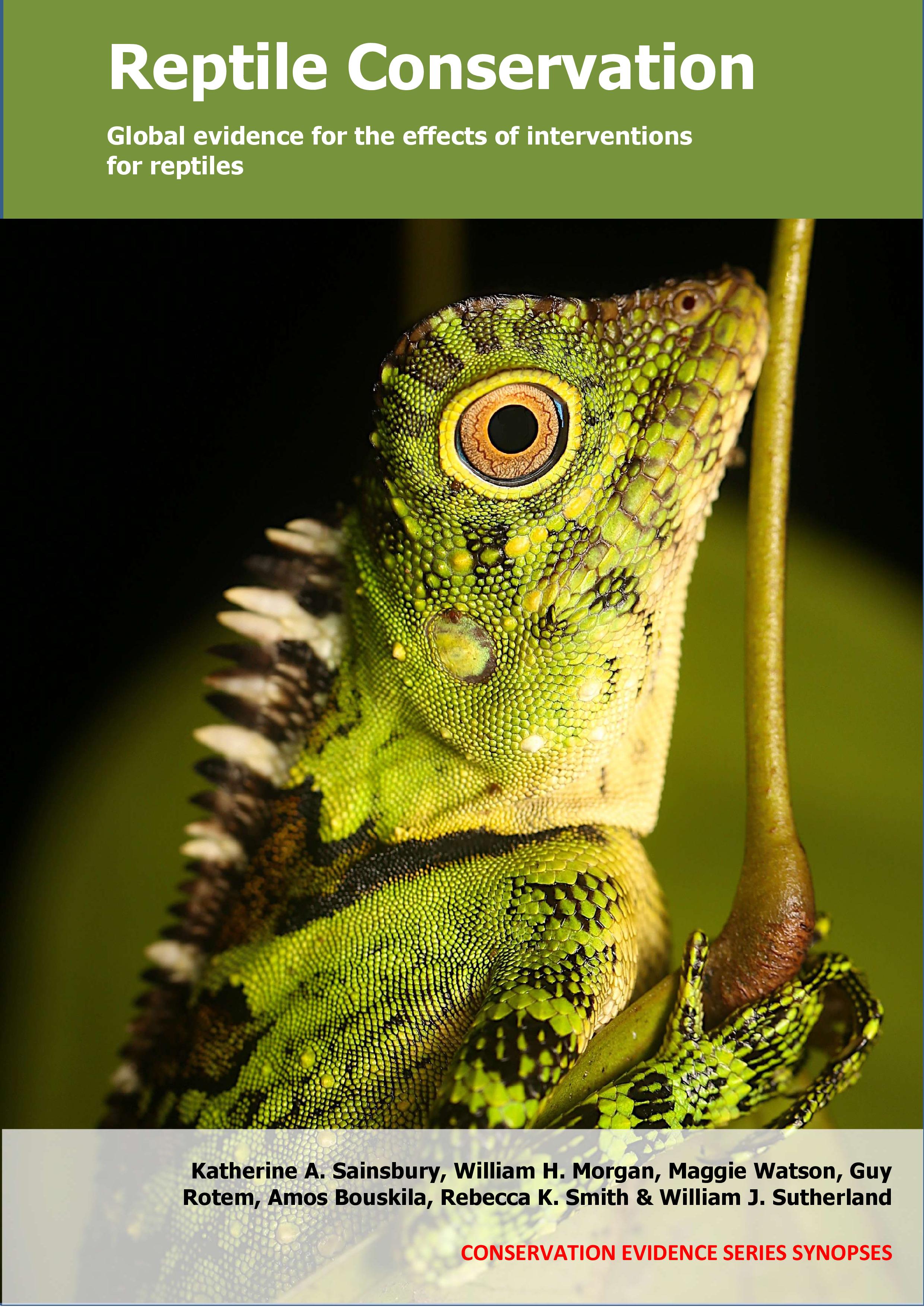Actions to conserve biodiversity
We have summarised evidence from the scientific literature about the effects of actions to conserve wildlife and ecosystems.
Review the evidence from the studies
Not sure what Actions are? Read a brief description.
Search for evidence
e.g. "frogs chytrid"
312 Actions found
Refine
Hide
312 Actions found
Download Actions
| 0 selected |
|
Order results by:
| Action | Effectiveness | Studies | Category | |
|---|---|---|---|---|
|
Sterilize equipment to prevent spread of disease Action Link |
No evidence found (no assessment) | 0 |
|
|
|
Switch to land-based aquaculture systems Action Link |
No evidence found (no assessment) | 0 |
|
|
|
Temporarily move reptiles away from short-term threats Action Link |
Awaiting assessment | 2 |
|
|
|
Thin trees within forests Action Link |
Awaiting assessment | 6 |
|
|
|
Train vessel operators on appropriate avoidance techniques to reduce collisions Action Link |
No evidence found (no assessment) | 0 |
|
|
|
Translocate adult or juvenile reptiles: Crocodilians Action Link |
Awaiting assessment | 2 |
|
|
|
Translocate adult or juvenile reptiles: Lizards Action Link |
Awaiting assessment | 17 |
|
|
|
Translocate adult or juvenile reptiles: Sea turtles Action Link |
Awaiting assessment | 2 |
|
|
|
Translocate adult or juvenile reptiles: Snakes Action Link |
Awaiting assessment | 14 |
|
|
|
Translocate adult or juvenile reptiles: Tortoises, terrapins, side-necked & softshell turtles Action Link |
Awaiting assessment | 26 |
|
|
|
Translocate adult or juvenile reptiles: Tuatara Action Link |
Awaiting assessment | 4 |
|
|
|
Translocate problem reptiles Action Link |
Awaiting assessment | 7 |
|
|
|
Translocate reptiles away from threats: Crocodilians Action Link |
Awaiting assessment | 1 |
|
|
|
Translocate reptiles away from threats: Sea turtles Action Link |
No evidence found (no assessment) | 0 |
|
|
|
Translocate reptiles away from threats: Snakes and lizards Action Link |
Awaiting assessment | 9 |
|
|
|
Translocate reptiles away from threats: Tortoises, terrapins, side-necked & softshell turtles Action Link |
Awaiting assessment | 9 |
|
|
|
Translocate reptiles away from threats: Tuatara Action Link |
Awaiting assessment | 1 |
|
|
|
Treat wastewater from intensive livestock holdings Action Link |
No evidence found (no assessment) | 0 |
|
|
|
Use ‘bioremediating’ organisms to remove or neutralize pollutants Action Link |
No evidence found (no assessment) | 0 |
|
|
|
Use a different bait type: Crocodilians Action Link |
No evidence found (no assessment) | 0 |
|
|
|
Use a different bait type: Sea turtles Action Link |
Awaiting assessment | 9 |
|
|
|
Use a different bait type: Snakes & lizards Action Link |
No evidence found (no assessment) | 0 |
|
|
|
Use a different bait type: Tortoises, terrapins, side-necked & softshell turtles Action Link |
Awaiting assessment | 2 |
|
|
|
Use artificial insemination Action Link |
Awaiting assessment | 1 |
|
|
|
Use barriers or vegetation to reduce artificial light Action Link |
Awaiting assessment | 1 |
|
Download Actions
| 0 selected |
|

Reptile Conservation - Published 2021
Reptile synopsis
Watch this search
If you are familiar with RSS feeds, please click the button below to retrieve the feed URL:
RSS feed for this searchIf you are unfamiliar with RSS feeds, we would suggest reading this BBC article.
Unfortunately, due to the number of feeds we have available, we cannot provide e-mail updates. However, you could use tools such as Feed My Inbox to do this for you.
What are 'Individual studies' and 'Actions'?
Individual studies
An individual study is a summary of a specific scientific study, usually taken from a scientific journal, but also from other resources such as reports. It tells you the background context, the action(s) taken and their consequences.
If you want more detail please look at the original reference.
Actions
Each action page focuses on a particular action you could take to benefit wildlife or ecosystems.
It contains brief (150-200 word) descriptions of relevant studies (context, action(s) taken and their consequences) and one or more key messages.
Key messages show the extent and main conclusions of the available evidence. Using links within key messages, you can look at the paragraphs describing each study to get more detail. Each paragraph allows you to assess the quality of the evidence and how relevant it is to your situation.
Where we found no evidence, we have been unable to assess whether or not an intervention is effective or has any harmful impacts.





)_2023.JPG)














